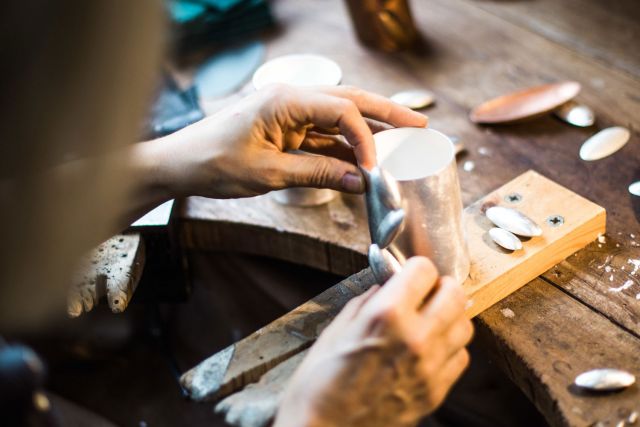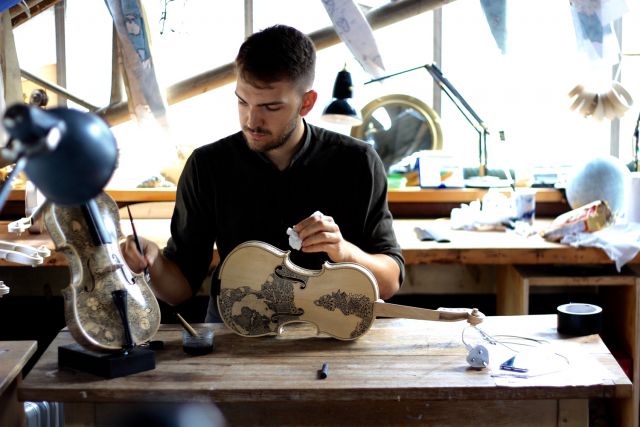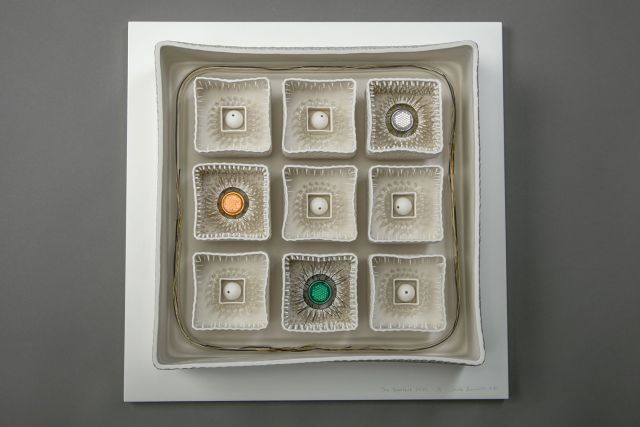Named after the Greek island of Paros, this kind of porcelain was designed in Staffordshire to imitate carved marble. Tamsin’s collection references the decoration of ornamental vases commissioned for the mantelpieces of grand 18th-century English mansions and their elaborately detailed foliate plasterwork. Tamsin “draws” the individual decorative elements using porcelain slip, then applies them one by one to the surface of each vase in an adaptation of traditional ceramic sprigging. By building up complex layers, she aims to create the feeling of the decoration slowly coming to life and taking over the vase in a tangle of glorious Baroque.
Height 20 cm
Diameter 15 cm
 in_studio_by_Vladimir_Jedlicka1_1738201.jpg.jpeg)
 bonechina_structures-credit Jacqueline Bilton.JPG.jpeg)
 psoriasis (skin layers detail).jpg.jpeg)
 Tamsin in lab (credit Jay Dacey).jpg.jpeg)
 in museum with medicines.jpg.jpeg)
Tamsin van Essen
- Ceramicist
- London, United Kingdom
- Master Artisan
Finding beauty in imperfection
- • Tamsin is fascinated by the scientific and medical world
- • She pushes the boundaries of what can be achieved with clay
- • Her work is inspired by the impermanence of material existence
Always a keen artist, when Tamsin van Essen left school she had to decide between art college or an academic degree – and chose the latter, studying physics and philosophy at Oxford University. That led to six years in science publishing, before she decided she would rather be working with her hands than sitting in front of a computer. A degree in ceramic design at Central Saint Martins and an MA at the Royal College of Art followed, but her earlier academic interests continue to inform her work. Often inspired by the scientific and medical world, she works conceptually, exploring the fine line between beauty and imperfection, attraction and repulsion. Her Medical Heirlooms series, based on common inherited diseases, aims to make us think about our emotional response to objects.
Read the full interviewWorks
Photo: © Tamsin van Essen

Photo: © Tamsin van Essen
Tamsin’s series of ceramic chatelaines incorporates modern versions of beauty tools. They are reinterpretations of the Victorian domestic health and beauty kits worn on a chain at the waist. Using polished bone china and porcelain for their association with luxury and domesticity, while overtly removing the functionality of the tools, Tamsin gives an ambiguous meaning to the pieces, a resemblance with amulets made from bones, talismans with magical properties to be worn for protection.
Height 36 cm

Photo: © Tamsin van Essen
White earthenware slip, applied to the surface of a low-temperature pink glaze, peels off a slip-cast earthenware ceramic apothecary jar. The peeling effect emulates the symptoms of a common skin disease, psoriasis. The jar is part of Tamsin’s greater Medical Heirlooms series in which she explores the stigma around diseases and questions contemporary obsessions with perfection and beauty.
Height 19 cm
Diameter 14.5 cm

Photo: © Vanitas Vanitatum
In her Vanitas Vanitatum series, Tamsin explores the ephemeral nature of beauty and the vulnerability of excess. The series is based on Dutch 17th-century Vanitas paintings and was inspired by the tragic allure of Satis House in Dickens’s Great Expectations, a symbol of dashed dreams and bitter disappointments. As demonstrated by this white ceramic vase, Tamsin aims to transpose to her works the fleeting moment when opulence turns into decay.
Height 27 cm
Diameter 19 cm

Photo: © Tamsin van Essen
In this decadent chocolate set, the porcelain pieces are eroded by yeast during the slip-casting process and seem to crumble away, evoking the fragile ghost of Marie Antoinette delicately drinking chocolate in her ornate salon.
Height 22.5 cm
Diameter 22 cm
Height 10 cm
Diameter 7.5 cm
Height 1 cm
Diameter 14 cm














